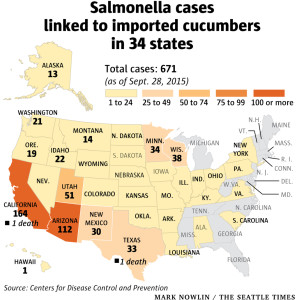 A nationwide outbreak of Salmonella-tainted cucumbers has afflicted states with increased illnesses and hospitalizations. While the U.S. Food and Drug Administration (FDA) has determined the source and cause of the outbreak, the damage has been done, and the case count is expected to rise in spite of the recent recall. Many are now asking the question: how can we better control food safety?
A nationwide outbreak of Salmonella-tainted cucumbers has afflicted states with increased illnesses and hospitalizations. While the U.S. Food and Drug Administration (FDA) has determined the source and cause of the outbreak, the damage has been done, and the case count is expected to rise in spite of the recent recall. Many are now asking the question: how can we better control food safety?
Shin Horikawa and his team at Auburn University believe their novel biosensor technology could resolve many of the current issues surrounding the spread of foodborne illnesses. As the principal scientist for a concept hand-picked for the FDA’s Food Safety Challenge, Horikawa is looking to make pathogen detection faster, more specific, and cheaper.
Faster, Cheaper, Smarter
“The current technology to detect Salmonella takes a really long time, from a few days to weeks. Our first priority is to shorten this detection time. That’s why we came up with a biosensor-based detection method,” says Horikawa, Postdoctoral researcher at Auburn University and member of ECS.
Horikawa and his team’s concept revolves around the placement of a tiny biosensor—a sensor so small that it’s nearly invisible to the human eye—on the surface of fresh fruits and vegetables to detect the presence of pathogenic organisms such as Salmonella. This on-site, robust detection method utilizes magnetoelastic (ME) materials that can change their shape when a magnetic field is applied. The materials respond differently to each magnetic field, changing their shapes accordingly. This allows the researchers to detect if a specific pathogen—such as Salmonella—has attached to the biosensor.
“Our technology could be used on-site. It’s really rapid. Salmonella can be detected anywhere from two to 10 minutes. The FDA’s current fastest method takes close to 26 hours,” says Horikawa.
Foodborne Illness in the United States
According to the CDC, 1 in 6 people in the United States is sickened by a foodborne illness annually. Approximately 3,000 deaths can be traced to foodborne illnesses, resulting in an overall cost of $77 billion per year.
In order to help combat this issue, the FDA reached out to scientists, entrepreneurs, and innovators to develop new methodologies to improve foodborne pathogen detection. The research by Horikawa and his team was picked as one of the top five finalists for the FDA Food Safety Challenge due to its novel use of a phage-based ME biosensor.
The Advantages of Phage
“We use phage as a biomolecular recognition element. We selected it for its many advantages. For example, the most commonly used biomolecular recognition element for biosensors is antibodies. Compared to these antibodies, phage is much more stable. Our phage-based sensors can be used at a high temperature for a long time,” says Horikawa.Additionally, the phage-based biosensor has a high degree of specificity. With this technology, pathogen detection could be applied to virtually any environment.
“If I want to detect Salmonella or any type of bacteria in irrigation water, lakes, in milk, or apple juice; we can synthesize phage in that specific environment,” says Horikawa.
Preventing Outbreaks
As of September 4, 2015, 285 people in the United States were infected with Salmonella due to the tainted imported cucumbers. Just 25 days after that initial announcement, the case count had gone up to 671 with 131 hospitalizations.
“Our technology can be used at point of entry,” says Horikawa. “With the recent Salmonella outbreak in cucumbers imported from Mexico, if we used our technology at the point of entry we could possibly detect the contamination.”
Get a closer look at some of Horikawa’s research by heading over to the Digital Library.
PS: Make sure to check out the Sensors for Agriculture symposium at the 228th ECS Meeting!


![[Click to enlarge]](https://www.electrochem.org/wp-content/uploads/2015/10/salmonella-276x300.png)
